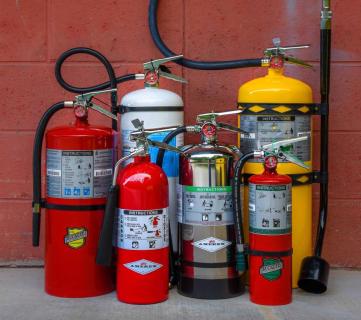Fire Safety Rules SIMPLIFIED!
Wait, what? Something got simpler?
Marine Fire Safety Requirements Have Changed
“Safety Moments, presented at CCA Stations and Posts”
By Chuck Hawley, San Francisco Station
An email from marine safety expert Ed Huntsman caught my eye. For those of you who haven’t run across Ed, he was the Recreational Boating Safety Program Manager at the Eighth Coast Guard district for many years, covering the Gulf Coast states and most of the Central United States.
Attached to the email was a 14-page extract from the Federal Register, describing a regulation that had been changed, how the Coast Guard had gone about getting input, what some of that input was, and how they reached their final decision.
The change, which takes place in the spring of 2022, concerns the inspection and documentation of portable fire extinguishers on mechanically-propelled vessels. What I didn’t realize until I read the Federal Register is that all recreational boat owners are obligated to inspect their fire extinguishers on a monthly basis and document that they had done so.
What, you haven’t been logging your fire extinguisher inspection?
This is apparently true even if the vessel hasn’t been used, or is in storage. Imagine going to the boat yard with a few feet of snow on the ground, and somehow climbing under the shrinkwrap so that you could check your extinguishers and jot the results in the logbook.
Remarkably, the list of required safety gear for a 35’ sail or power boat is remarkably short. Life jackets and throwable flotation, navigation lights, visual distress signals, a sound making device, and a couple of fire extinguishers is pretty much all you’re required to have.[1]
In a world where everything seems to get more complicated and time-consuming (doing one’s taxes, getting a passport renewed, adopting a puppy from the SPCA, selecting the right oil for your car, comparing the nutrition labels on cereal boxes), the Coast Guard actually made something simpler for boaters. Readers of my previous Safety Moments may remember the February 2016 edition regarding the elimination of carrying SOLAS signals on racing sailboats in various categories of races. In that article, I marveled that an equipment requirement was reduced rather than the opposite.
You can imagine that if you were a paying passenger on a ferry boat, or a cruise ship, or even a whale watching boat, you’d want someone to check the gear and make sure it was in tip-top shape. That’s what the Coast Guard requires of inspected vessel operators. But the burden to inspect fire extinguishers was seen as having too little benefit for recreational boat owners.
During the comment period for the recommended changes, one of the opponents to the change was the NFPA or National Fire Protection Association. Their argument was along the lines of fires on recreational boats can be deadly, fire extinguishers are valuable, inspected fire extinguishers are more likely to work when needed, and the current regulation is not excessively burdensome. No one would fault a safety organization for arguing in favor of reliable fire fighting gear, but when is the hassle not worth the benefit?
The Coast Guard reasoned that self-administered “regular” inspection of fire extinguishers would be sufficient. Call it the honor system, rather than the enforced system. The Coast Guard recommend that you ensure that your portable fire extinguishers meet the following requirements:
In order to clarify the phrase ‘‘good and serviceable,’’ we added that the fire extinguisher lock pin must firmly be in place, the discharge nozzle be clean and free of obstruction, the extinguisher must not show signs of significant corrosion or damage and the portable fire extinguisher must be readily accessible.
Many marine fire specialists would add that you should turn your fire extinguisher upside down several times to make sure the extinguishing agent is free-flowing and not packed into the bottom of the cylinder, plus the obvious requirement to check the gauge and make sure it’s in the “green” zone. If the fire extinguisher is not in an obvious visible location, its location should be marked with a label or sign.
So how big a problem are fires on recreational boats? In 2019, according to the publication Boating Statistics, published by the Coast Guard Office of Boating Safety, 5 boaters were killed by fires or explosions while boating. By comparison, 189 died from “falls overboard” and 129 from “capsizing”. Perhaps the Coast Guard’s focus on getting boaters to wear life jackets is justified, based on this information, while having tough requirements on fire extinguishers is on the back burner, where it belongs.
EPILOG: Apparently this change has been further modified since I originally wrote this. Now the law requires that portable, non-refillable fire extinguishers (generally, those with a plastic valve assembly) be replaced after 12 years. The date code on the bottom of the cylinder can help you identify those that are candidates for replacement.
The Cruising Club of America is a collection of accomplished ocean sailors having extensive boat handling, seamanship, and command experience honed over many years. “Safety Moments” are written by the Club’s Safety Officers from CCA Stations across North America and Bermuda, as well as CCA members at large. They are published by the CCA Safety and Seamanship Committee and are intended to advance seamanship and safety by highlighting new technologies, suggestions for safe operation and reports of maritime disasters around the world.
[1] Yes, dear reader, you also need a couple of garbage disposal plaques, a compliant head installation, and a ventilation system and backfire arrestor for a gasoline powered boat. Oh, and a copy of The Rules of the Road for boats over 40’. I always have a hard time including those items with true “safety” items.






